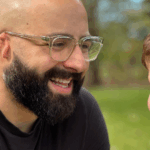MED-EL
Published Dec 12, 2018
How An Individualized Cochlear Implant Helped My Son To Hear

With cochlear implants, it isn’t a case of “one size fits all”—your implant should fit your individual cochlea. This is known as an individualized cochlear implant, and is the ideal way to make the most of your hearing. But for someone with an ossified cochlea, having a cochlear implant that is specially made for their unusual cochlea is often the only way they can hear at all.
One of those people is 13-year-old Kadu from Brazil. We first met Kadu earlier this year, when his mom, Debora, told us all about the effect one cochlear implant had had on her son’s life. Kadu recently took the big decision to get a second implant. Due to his ossified cochlea, the doctors were unsure if the operation would be successful. In this post, Debora explains how Kadu’s individualized cochlear implant gave him a hearing miracle that no one expected.
A Bilateral Cochlear Implant
We actually never planned to get a bilateral cochlear implant. Kadu’s progress with one implant was much better than expected, he had completed the rehabilitation process, and had great speech. So initially, he did not see a need for a second cochlear implant.
Then one day, while in the waiting room at the doctor’s office, Kadu began to read an article in a magazine about bilateral hearing. Suddenly he asked me, “Mom, did you know that with bilateral hearing, you can recognize where a sound is coming from more quickly? Does the same thing happen with bilateral implants?”. Before I had a chance to reply, Kadu said, “I’m going to get the bilateral implant, it’s going to get better at school.”
And our decision was made. We went to the doctor and we started the pre-surgery procedure.
An Ossified Cochlea
Kadu had meningitis as a baby, and it had ossified his cochlea. That meant that the fluid and soft membrane in his cochlea had gone hard—meningitis had turned Kadu’s cochlea as hard as stone. This would make it difficult to insert a cochlear implant electrode array properly.
In the beginning, the doctors had many doubts about how well an implant would work due to the ossification of Kadu’s cochlea. The possibility of failure was even considered. Dr Eduardo, Kadu’s surgeon, wanted to limit this risk as much as possible. He chose a MED-EL individualized cochlear implant with a compressed electrode array, because its small size made it good for an ossified cochlea like Kadu’s.
The surgery was a difficult procedure and full of complications, mainly due to the ossification of Kadu’s cochlea. During the surgery, they also discovered that the ossification had trapped liquid in his cochlea. Thankfully, Kadu had a very experienced surgeon who knew how to carry out the surgery in the best way possible. But I cannot forget Dr Eduardo’s face when he gave me the news that the surgery had not been as planned.
A Difficult Wait
It was a very difficult time for all of us after Kadu’s surgery, similar to the pain I felt when I first found out about his hearing loss.
Dr Eduardo’s expectations after the surgery were not the best. The liquid that was trapped in Kadu’s cochlea meant that the post-surgery scan wasn’t clear enough to know for certain if the surgery had been successful or not. However, Dr. Eduardo made it clear to me that the situation wasn’t hopeless, the electrode array had been inserted, and that we should wait for the activation. Only then would we know the final result.
As far as possible, we did not create high expectations for activation. While waiting for the day to come, we prepared ourselves for the fact that the cochlear implant may not work. The open attitude of the CI team was undoubtedly the best part of that wait. Kadu had weekly meetings with them and every time he returned feeling calm and confident.
Dr. Eduardo always had a friendly and optimistic word to say to us. He explained in simple language what meningitis was, the damage it caused to the cochlea, showed what had happened in the surgery, and what could be done in the future depending on the response at activation. This support was fundamental in the 42 days between surgery and activation.
A Successful Activation
Activation day was an emotional show. They turned on Kadu’s audio processor and he could hear. Kadu could hear with his implant! It was a miracle. I felt like my heart would go out through my mouth. I hugged, kissed, and squeezed the audiologist. I must have looked crazy! A crazy mother full of happiness.
And the emotional roller coaster didn’t stop there.
Two days after activation, we were sitting on a bench and Kadu turned to me and said, “The battery has run out on my new processor.” I looked at his SONNET and its battery warning light was not blinking. I just assumed he was mishearing the warning signal. Then, with all the certainty of a successful bilateral recipient, he repeated: “… the battery is empty, mother, I noticed the whistle that the implant does when the battery is going to end … or else it stopped working because I am not hearing anything with it.”
In a desperate act, we switched off the processor and turned it on again. Kadu said again that the battery was empty. “The device warns me before it stops working and I heard the beeps.” At that moment, Kadu’s SONNET’s red light started flashing, signaling that it was time to change the battery. He’d been right all along.
He could hear the noise the processor makes to warn you that the battery is running low. How was this possible after only two days of activation? Kadu simply loves to hear.
A Better Way To Hear
And now Kadu loves being able to hear with two implants. “It’s very different and it’s better listening with two implants. I’m still learning, but I can already understand several things.” He’s only had five months of rehab so far and the results are amazing. Kadu can already recognize and identify several sounds and is a lot further on in his rehab than his audiologist expected him to be.
You really notice that Kadu is able to locate sounds better than before. One day, I was in the kitchen and Kadu was in another room, I did not know which one. I needed him and called him: “Kaduuuuu!” Suddenly I heard the sound of the door of the bathroom in his room opening and from there that wonderful voice saying, “Mother I’m in the bathroom, I’ll come down when I’m done”.
Wow! How did he do that? He could hear from inside the bedroom bathroom, even with the door closed.
I began to question how that had been possible and he very wisely told me: “I could hear through this wall,” pointing to the kitchen wall that is next to the bathroom. That is, he heard and located the sound through the wall from the bathroom. This would never have been possible when he only had one implant.
A Bright Future
My priority will always be to continue helping Kadu build a bright future full of sounds and opportunities, and to not let his determination to hear disappear.
If you’re thinking of getting a second implant, you should first check with your medical team if there are favorable conditions for performing the surgery. Your choice of doctor and team is very important—a committed team makes a big difference and leaves you safe, whatever the results.
We must not forget that choosing modern, innovative technology is essential to complete this marriage (not divorce) between cochlear implants and hearing loss, particularly if you have an ossified cochlea like Kadu. And of course, family plays a huge role.
It is gratifying to see that my greatest wish is being realized, which is to make Kadu a good man. My struggles were not in vain. And for Kadu, he wants to continue listening much more every day and to take advantage of all the benefits that his bilateral implants give him.
Thanks, Debora!
Find out more about how invidualized cochlear implants can help your hearing.
Interested in going bilateral? Discover the advantages of having two cochlear implants.
MED-EL
Was this article helpful?
Thanks for your feedback.
Sign up for newsletter below for more.
Thanks for your feedback.
Please leave your message below.
Thanks for your message. We will reply as soon as possible.
Send us a message
Field is required
John Doe
Field is required
name@mail.com
Field is required
What do you think?
MED-EL


